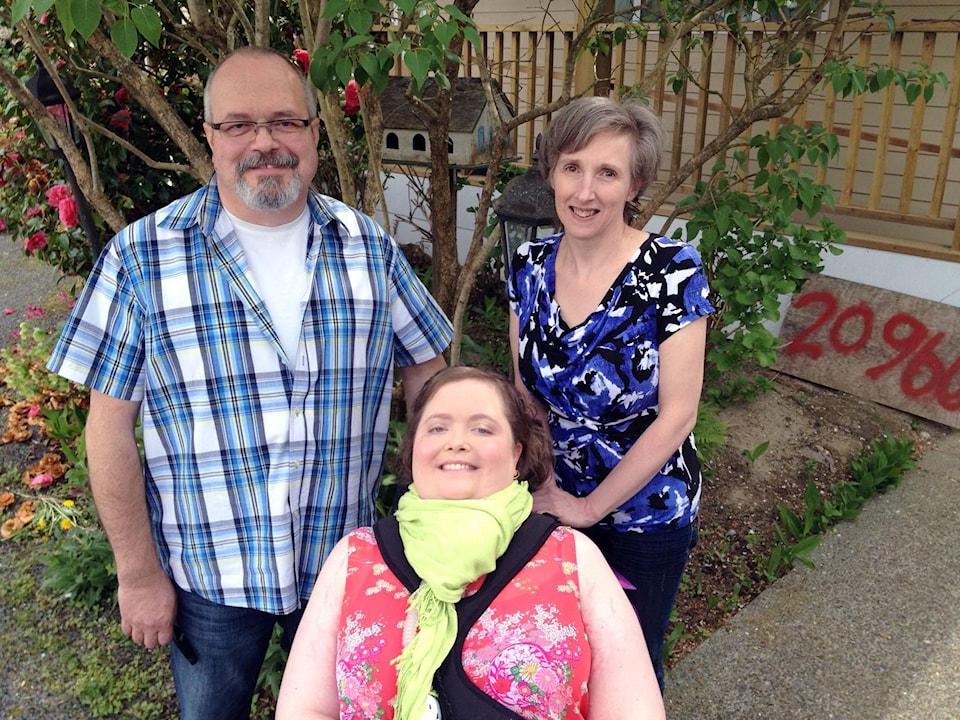LANGLEY — It's not often that someone is relieved to get a diagnosis that results in losing most of their muscle control.
But for Erin Kreiter, finding out that she has myasthenia gravis was better than always being told that her illness was an attention-seeking ploy.
Even if you don't know Latin, the word "gravis" would set off warning bells. Indeed, there is no cure for "grave muscle weakness." A chronic autoimmune neuromuscular disease that's a cousin to muscular dystrophy, myasthenia gravis means that the message from nerve to muscle doesn't get through.
Today, the 29-year-old PhD candidate requires 24-hour care. If her respirator - the machine that does the job her muscles in her diaphragm can no longer do - fails, she could breath on her own for only a minute. Her eyes are slightly droopy because keeping your eyes open requires muscle too. She can move her fingers and wrists, and wiggle her toes, but that's about it.
(function(){var e=document,t=e.createElement("script");t.type="text/javascript";t.async=true;t.src=(e.location.protocol.indexOf("https")==0?"https://s-":"http://")+"static.fundrazr.com/widgets/loader.js";var n=e.getElementsByTagName("script")[0];n.parentNode.insertBefore(t,n)})()
Please donate now
Erin has had a lot to cope with since she walked into a hospital in August of 2012 and came home to Langley in an electric wheelchair 360 days later. But instead of concentrating on what she can't do, she focuses on what she can do. And top of that list is being able to live at home with her mom Janet, who works at the Trinity Western University Library, and her dad Tim, an RCMP officer who's on leave until they can ensure they have round-the-clock caregivers seven days a week.
"It's great, it's crazy, it's scary, it's wonderful, it's all of those things," Erin says of what it's like to be at home. In healthcare facilities, she spent a lot of time waiting for staff to help her. At home, the round-the-clock help from a caregiver means "I can go out and have a life. I can get back to my studies in September. I can have my friends over, go out to the movies or go out for dinner. I can take my puppy for a walk.
"[The hospital] is a life of waiting and spending a lot of time alone in your room. I couldn't imagine doing it for the next 50 years. I did it for a year and that was enough."
It's not without cost, however. The entire house had to be retrofitted to create a main-floor bedroom and accessible bathroom. The sunken living room floor was raised, walls were removed to make room for her wheelchair's furniture-wreaking movements, doorways were widened, a wheelchair ramp was installed.
Friends and family helped out by lending them money and the Kreiters took out a second mortgage to pay roughly $200,000 in bills. All those loans need to be paid back.
Those financial worries are a source of stress but the main thing is to have Erin back at home.
"We're getting it figured out," says Janet. "We've come a long way. It's a huge amount of work but once you get it figured out...."
"It's the new normal," Erin adds. Her mother nods her head. "You just do it."
DOCTORS THOUGHT IT WAS IN HER HEAD
Ever since she was young, Erin Kreiter has been ill. But for years it was misdiagnosed as severe asthma because of the difficulties she had breathing. Then, when the asthma treatments didn't work and there was no other obvious cause, medical officials fell back on thinking the illness must therefore be in her head.
She says it got so bad that when she'd show up at the hospital emergency department, the staff would recognize her and ignore her for as long as they could.
There are two ironies at play here.
Erin, who earned a Bachelor of Science at Trinity Western University, is in the midst of her PhD. Her thesis? The roadblocks cancer patients face as they work their way through the healthcare system.
Her dad, Tim, is an RCMP officer who specializes in fraud. While doctors suspected his daughter was faking her illness, his job was to seek out and expose people who had turned faking into a way of life.
"The one thing that's taught to all officers is not to get tunnel vision," he says. "Follow the evidence and build your theory after you have all the evidence. Don't have a theory and fit in the evidence, which in some ways happened to Erin. Instead of saying the treatment isn't right or the diagnosis isn't right, they said it was in her head."
His advice to doctors is the same he'd give to young police officers: "Follow the evidence, don't follow the theory."
As Erin says, "If someone doesn't fit into your box of diagnoses, there might be a different box."
